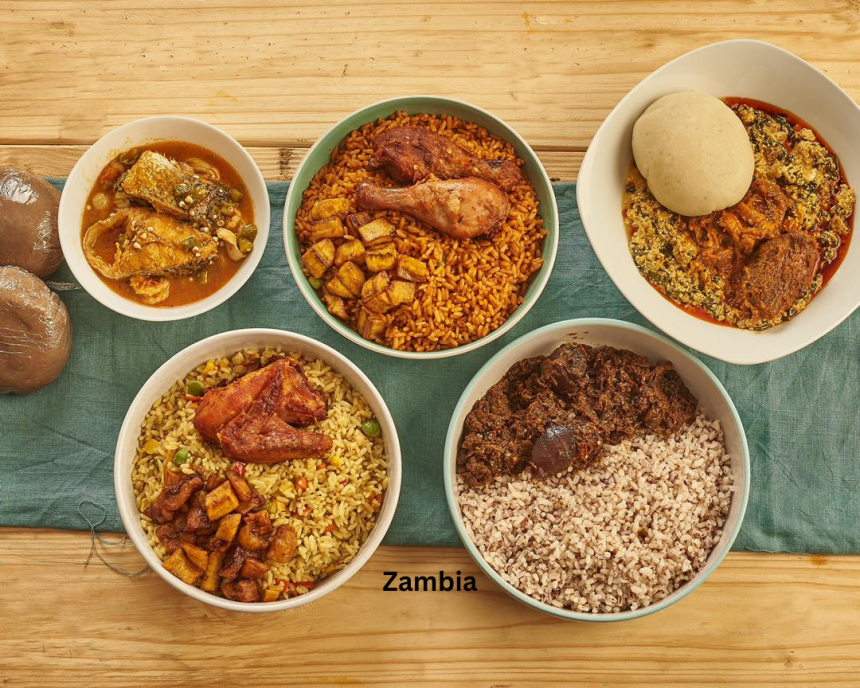Ever wondered what it’s like to dine on exotic meats in Africa? Then pack your sense of adventure and appetite for the unique and unfamiliar, because Zambia awaits. This landlocked southern African nation is home to some of the most distinctive meat dishes on the continent. As a visitor, you’ll encounter protein sources you’ve likely never tried before. From crocodile tail to impala stew, caterpillars to cane rats, Zambian cuisine offers carnivorous delights for the intrepid foodie. With 13 national parks and over 40% of the country set aside for wildlife conservation, Zambia has no shortage of wild game and bushmeat. So grab a chair, pull up to the table, and get ready to dive into a meat-lovers paradise like no other. The adventure starts now.
Beef and Goat: Staples of Zambian Cuisine
When in Zambia, you can’t miss the opportunity to try the delicious beef and goat dishes. These meats are staples of Zambian cuisine.
Beef is popular and found throughout the country. Look for beef stew, made with onions, chili peppers, and spices simmered for hours until the meat is fall-apart tender. Beef curry, flavored with curry spices and coconut milk, is also common. Grilled beef skewers, called mshima, are a favorite street food.
Goat meat is widely eaten, especially in northern Zambia. Goat stew and goat curry, prepared similarly to the beef versions, are popular. Goat meatballs, called ifisashi, are also common. They’re made from ground goat meat, onions, and chili peppers, then stewed in a tomato-based sauce. For a special occasion, try nshima ya ng’ombe, pounded beef and goat meat served with a side of nshima, the Zambian cornmeal staple.
Whether beef, goat, or a combination, these protein-packed dishes are usually accompanied by nshima to soak up the flavorful sauces, as well as fresh vegetables like pumpkin leaves, okra, or eggplant. Wash it all down with a Mosi, Zambia’s favorite beer, or a cup of chibwantu, a non-alcoholic beverage made of cornmeal, sugar, and spices.
With such a variety of beef and goat specialties, you’ll never run out of new and exciting Zambian meat dishes to try. Sink your teeth into these savory staples and experience the heart of Zambian cuisine.
Impala and Kudu: Game Meat Specialties
Some of the most prized meats in Zambia come from wild game like impala and kudu. If you’re an adventurous eater, these distinctive flavors are worth seeking out.
Impala meat is tender and mildly sweet, resembling high-quality beef. Kudu has a richer, gamier taste and texture similar to venison. Both are packed with nutrients and considered delicacies.
To sample impala or kudu, head to a market or butcher that sells wild game, or look for it on the menu at restaurants featuring traditional Zambian cuisine. Impala and kudu can be prepared in similar ways as beef – grilled, stewed, or roasted. A few popular dishes include:
- Impala stew: Cubed impala meat simmered in a sauce with onions, chili peppers, and vegetables. Usually served over rice, nshima (maize porridge), or with bread.
- Kudu potjiekos: Kudu meat and vegetables cooked over an open fire in a cast iron pot. A South African-inspired dish that has become popular in Zambia.
- Impala or kudu burgers: Ground meat patties, often mixed with beef or pork, and grilled. Topped with ingredients like cheese, onions, chili sauce, and coleslaw.
Whether you’re enjoying a hearty stew, potjiekos, or burger, impala and kudu meats are flavorful alternatives to more common red meats. And by choosing these wild game specialties, you’ll get a true taste of Zambia’s culinary heritage. Dig in and enjoy!
Crocodile Tail: A Delicacy for the Adventurous
Crocodile tail is considered a delicacy in Zambia and reserved for special occasions. Only the adventurous will seek out this exotic meat, but those who do are rewarded with a unique taste and texture.
Hunting and Preparation
Crocodiles are hunted in the wild, mainly in the Luangwa and Zambezi rivers. The tails are removed and transported to markets where they are sold whole or in cuts. The tail meat is quite tough, so it requires extensive preparation to become tender enough to eat. It is usually boiled for several hours, then grilled or fried before serving. Some recipes also call for pounding the meat to further break down the fibers.
A Distinctive Flavor
Crocodile tail has a slightly fishy flavor from the animal’s aquatic diet. The meat is described as tasting like a mix of fish, chicken, and crab. It has a firm, chewy texture even after cooking due to its muscular nature. The flavor is mild enough that it pairs well with local spices like chili peppers, garlic, and fresh herbs. A tomato-based stew is also commonly served with crocodile tail.
An Uncommon But Prized Dish
While crocodile tail may seem exotic and strange to outsiders, it has been part of Zambian food culture for generations. It is most popular in the northern and eastern parts of the country, especially in areas where crocodiles are more prevalent. Because crocodiles are protected in Zambia, their meat can be expensive. Crocodile tail is considered a status symbol and delicacy reserved for special guests and celebrations. Trying this dish provides a unique opportunity to experience an important part of Zambia’s culinary heritage.
For the adventurous eater looking to try new and unusual foods, crocodile tail offers an experience found nowhere else. While its distinctive taste and chewy texture may surprise you at first, an open mind will allow you to appreciate this delicacy that is an integral part of Zambia’s culture. Expanding your palate to include crocodile tail provides insight into the diverse flavors that make up Zambian cuisine.
Zambian Chicken and Eggs: More Than Just Breakfast
Chicken and eggs are staples of Zambian cuisine that go far beyond breakfast. Zambians have developed creative ways to cook and enjoy poultry that highlight its versatility.
Nshima and Chicken
No Zambian meal is complete without nshima, a thick porridge usually made from maize flour. Nshima is always accompanied by a meat, vegetable or legume stew called ndiwo. Chicken ndiwo, made with chicken, onions, chili peppers and spices, is a popular choice. The chicken is braised until tender and the sauce is rich and flavorful. Scoop it up with your hands and enjoy!
Chicken Curry
Chicken curry, influenced by Indian cuisine, is another favorite. Chicken pieces are simmered in a blend of spices like coriander, cumin, turmeric and chili to make a fragrant curry sauce. Coconut milk provides a creamy base, and the dish is often garnished with cilantro. Rice, naan bread or nshima help soak up the flavorful sauce.
Eggs
Eggs are an important source of protein and used in many Zambian recipes. A common street food is egg rolls or egg burgers, where hard boiled eggs are mashed and seasoned, then fried in a patty. Egg mayonnaise, made from mashed hard boiled eggs, mayonnaise and spices, is popular as a sandwich filling or dip.
For breakfast, eggs are usually scrambled or made into an omelet with onions, tomatoes, chili and cheese. They are often served with nshima, bread, or fried plantains.
Whether for breakfast, lunch or dinner, chicken and eggs provide sustenance and comfort in Zambia. Sample these distinctive dishes for a taste of Zambian culture and hospitality. Your taste buds will thank you!
Zambian Pork: From Sausages to Chops
Zambian pork dishes showcase the diversity of flavors in Zambian cuisine. From sausages to chops, pork is prepared in many mouthwatering ways.
Zambian Pork Sausages
Zambian pork sausages, known as “polony,” are seasoned ground pork stuffed into natural casings. They are usually fried or grilled and served in a bun, often topped with onions, chili sauce, and cabbage. Polony is a popular street food in Zambia, sold by vendors and in markets. The blend of spices used in the sausage can vary but typically includes black pepper, nutmeg, and chili peppers for some heat.
Pork Chops
Juicy pork chops, or “pork steak,” are also commonly eaten in Zambia. The chops are marinated in a flavorful blend of spices and aromatics like garlic, ginger, and lemon or lime juice before being grilled, baked, or pan-fried. A side of nshima, Zambia’s staple cornmeal porridge, is perfect for soaking up the flavorful juices. Some recipes also call for basting the chops in a chili garlic sauce or honey mustard glaze while cooking for extra flavor.
Other Pork Dishes
In addition to sausages and chops, Zambians enjoy:
- Braised pork with onions, tomatoes and chili peppers. The long, slow cooking results in very tender meat.
- Pork curry, where chunks of pork are simmered in a coconut-based curry sauce spiced with chili peppers, turmeric, cumin and coriander.
- Pork stew, with onions, peppers, tomatoes and peanut butter or groundnuts.
Whether in a bun, on a plate, or in a pot, pork prepared in the Zambian style is full of spice, flavor, and comfort. Exploring Zambia’s pork dishes is a delicious way to experience the country’s culinary heritage.
Insects: A Surprisingly Popular Source of Protein
Insects are a popular source of protein in Zambia and considered a delicacy by many. Don’t be surprised to find locusts, caterpillars, and termites on the menu.
Locusts
Locusts are grasshoppers that swarm in large numbers, and when cooked, have a shrimp-like flavor. They are usually sun-dried, then boiled or fried. The dried locusts can be eaten whole like chips or milled into a flour to make porridge. Locusts are an excellent source of protein, healthy fats, iron, and zinc.
Caterpillars
Caterpillars, especially the mopane caterpillar, are prized for their meaty texture and nutty flavor. They are usually boiled, sun-dried, or fried and eaten whole. The dried caterpillars can also be ground up to make a flour for porridge or bread. Like locusts, caterpillars contain many nutrients, including protein, iron, and B vitamins.
Termites
Termites, specifically the large queen termites, are considered a delicacy. They have an almond-like flavor and crunchy exoskeleton. Termites are usually fried or roasted and eaten whole. They are rich in protein, healthy fats, and minerals like copper, manganese, and selenium.
While the idea of eating insects may seem strange or off-putting to some, they have been an important source of nutrition for Zambians for generations. Insects are eco-friendly, sustainable, and help support food security in Zambia. So, next time you’re in Zambia, expand your palate and give the local insects a try—you may be pleasantly surprised! Your taste buds are in for an adventure.
Fish From Zambia’s Rivers and Lakes
Zambia is home to many rivers, lakes and dams, so it’s no surprise that fish is an important part of the local diet. Two of the most popular types of fish are bream and kapenta.
Bream
Bream is a freshwater fish found throughout Zambia, especially in Lake Tanganyika and the Zambezi River. It has a mild, flaky white flesh that is often compared to tilapia. Bream can be grilled, fried, or stewed and is usually served with nshima or rice.
Kapenta
Kapenta are small sardine-like fish that live in large schools in Lake Tanganyika and Lake Mweru. To catch kapenta, fishermen use large nets and specially-designed boats. Kapenta have a strong, oily flavor and are usually sun-dried, smoked or salted. They are an important source of protein for many Zambians.
- Sun-dried or smoked kapenta can last for several months and are often used to make relishes, stews and sauces to serve with nshima or rice.
- Fresh kapenta are usually fried and eaten whole, while the dried ones need to be rehydrated before cooking.
- Kapenta from different lakes have slightly different flavors due to variations in diet and water conditions. Lake Tanganyika kapenta are considered the tastiest by many Zambians.
Other popular Zambian fish include mpasa, a type of catfish found in the Kafue River, and ngwesi, a sardine-like fish caught in Lake Mweru. For many Zambians, especially those living in rural areas, fish provides an affordable source of protein to supplement a diet based mainly on grains, tubers and leafy greens. The variety of fish found in Zambia’s many waterways contributes to the diversity of its cuisine.
How Zambian Meat Is Traditionally Prepared
Zambian meats are traditionally prepared in ways that maximize flavor. The cooking techniques have been passed down through generations and are an important part of Zambia’s food culture.
Slow Cooking
Many Zambian meat dishes are cooked low and slow to become extremely tender. Meats like beef, chicken, and goat are often braised, stewed, or grilled over an open fire. Braising involves browning the meat, then simmering it in a covered pot with some liquid like broth or beer until the meat becomes fall-apart tender. Stewing is similar but uses more liquid and results in a saucier dish. Grilling over hot coals allows the meat to pick up a delicious smoky flavor. These long, slow cooking methods result in meats that are meltingly tender and packed with flavor.
Spicing and Marinating
Zambian meats are usually well-seasoned or marinated before cooking. Common spices include chili peppers, garlic, ginger, and curry. Meat is often rubbed with or marinated in a blend of these spices along with acidic ingredients like lemon or lime juice to help break down the fibers. The spices and marinades help the meat develop a robust, complex flavor as it cooks.
Side Dishes
Meat dishes in Zambia are usually served with a starchy side like nshima, a cornmeal porridge; rice; or fufu, which is made from boiled and pounded starchy vegetables. Greens like collard greens, pumpkin leaves, or bean leaves provide nutrition and balance out the meal. A variety of fresh salsas, chutneys, and sauces made from tomatoes, onions, chili peppers, and peanuts are also commonly served on the side for drizzling and dipping.
The traditional methods of preparing and serving meat in Zambia result in a truly flavorful culinary experience. Slow cooking, spicing, and pairing the meat with fresh sides and sauces all contribute to the distinctive taste of Zambian cuisine. Trying authentic Zambian meat dishes is a great way to get a sense of the country’s culture and history.
Where to Sample Authentic Zambian Meat Dishes
Zambia is known for its delicious and hearty meat dishes, ranging from stews to grilled meats. To experience authentic Zambian meat cuisine, head to the following places:
Local Markets
Zambian open-air markets are a great place to find vendors selling traditional meat dishes like ifisashi, a beef and vegetable stew, and chikanda, grilled meat skewers. Two of the largest markets are in Lusaka, Zambia’s capital city:
- Soweto Market: Open daily, you’ll find stalls selling beef, chicken, and goat meat, as well as fresh produce. Try the ifisashi or nshima, a cornmeal porridge meant for dipping in stews.
- City Market: Open daily, this historic market dates back to the 1930s. In addition to meat and produce, you’ll find vendors selling handcrafts, fabrics, and spices. Grab some chikanda or grilled chicken with nshima.
Local Restaurants
For an authentic meaty meal in a more formal setting, check out these popular local restaurants:
- Mama Mia’s: A casual local favorite in Lusaka featuring Zambian-Italian fusion fare. They offer chikanda, grilled crocodile, and impala burgers.
- Marlin Restaurant: Upscale spot serving traditional Zambian cuisine with a contemporary twist. Menu items include peanut chicken, grilled guinea fowl, and Zambezi bream fish. They also offer vegetarian options with fresh produce.
- Mama Betty’s BBQ: Popular roadside BBQ joint in Livingstone, near Victoria Falls. They are known for their succulent beef, chicken, and pork ribs, as well as whole grilled fish. Everything is cooked over hot coals for maximum flavor.
- The Courtyard Cafe: Charming cafe located within a nursery in Lusaka. They serve light meals, snacks, and Zambian coffee. On Sundays, they offer a traditional Zambian lunch buffet with dishes like ifisashi, chikanda, and fresh salads.
Whether at a lively local market, casual roadside stop, or upscale restaurant, you’ll find delicious grilled meats and hearty stews to sample in Zambia. Enjoy your meal and don’t forget the nshima to soak it all up!
Conclusion
So there you have it, a taste of Zambia’s most distinctive meat dishes. From crocodile tail to impala stew, Zambian cuisine offers adventurous eaters a range of unique flavors and textures to experience. While you may not find all these meats readily available in your local supermarket, many Zambian restaurants around the world do offer traditional fare made with exotic meats. If you get the chance to visit Zambia, make sure to sample as many of these dishes as possible—your taste buds will thank you for the culinary adventure. A trip to Zambia isn’t complete without trying the local cuisine, so dive in and savor the tastes of this amazing country.



